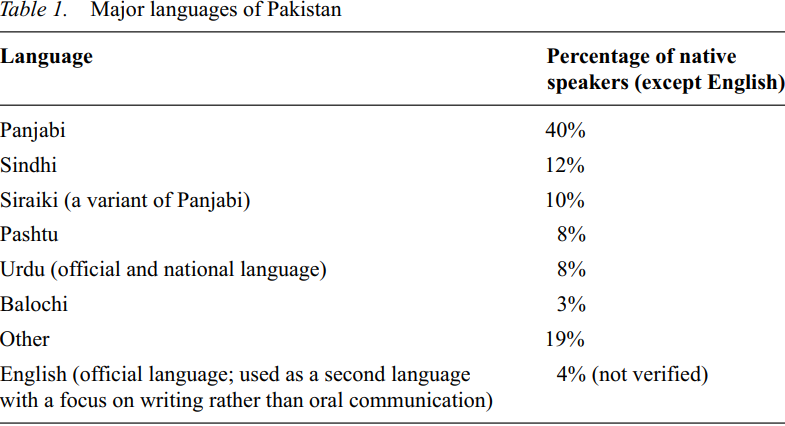
Pakistani languages and PakE
 المؤلف:
Ahmar Mahboob and Nadra Huma Ahmar
المؤلف:
Ahmar Mahboob and Nadra Huma Ahmar
 المصدر:
A Handbook Of Varieties Of English Phonology
المصدر:
A Handbook Of Varieties Of English Phonology
 الجزء والصفحة:
1005-59
الجزء والصفحة:
1005-59
 2024-06-11
2024-06-11
 1593
1593
Pakistani languages and PakE
While work on South Asian English suggests that there is a need for a description of a pan-South Asian model of English, it also recognizes differences between various sub-varieties of South Asian English (Kachru 1983). These sub-varieties are defined in terms of local languages. Thus, PakE and Indian English have unique features based on the differences in the vernaculars of the population of each country (and on the different political, educational and economic policies of each country). Similarly, PakE itself is heterogeneous not only because of the socio-economic, geographic, and educational background of the people who speak it, but also because of the various first languages of its speakers. An example of this is the difference in the placement and quality of the epenthetic vowel in English spoken by native speakers of Urdu and Panjabi.

Another example of variable influence of first language on PakE concerns the realization of [Ʒ]:

In this example, the [Ʒ] is either realized as a [j] or a [ʤ] by Panjabi speakers of PakE. The exact distribution of this variation has not been studied.
These examples of differences in PakE suggest that there may be considerable variation within PakE based on speakers’ first language. Pakistan is a multilingual country with at least 69 living languages (Ethnologue 2002), and speakers of these different languages may be predicted to speak English differently. Unfortunately, at present, there is no research that explores the extent of influence of various mother tongues on PakE(es). A review of the small number of studies that focus on PakE is presented in the companion paper on PakE in the syntax volume.
The dominant (numerically and politically) languages of Pakistan include (in alphabetical order), Balochi, English, Pashtu, Panjabi, Sindhi, Siraiki, and Urdu. The percentage of native speakers of these languages is given in Table 1 below. The numbers (except for English) provided in Table 1 are based on the CIA World Fact Book (2002). The estimated percentage for English is based on the literacy rate of 42.7%, and the ratio of English medium schools. In interpreting the numbers provided in Table 1, the total estimated population of Pakistan, of approximately 150 million, should be kept in mind. Thus a seemingly tiny 3% of Baluchi speakers corresponds to about 4.5 million people. Similarly, if English is spoken with some proficiency by 4% of the Pakistani population, the number represented is approximately 6 million people, more than the total population of New Zealand.

Although this information has not been fully utilized in research on PakE at present, it is hoped that future research will explore the relationship between PakE(es) and various indigenous languages. It might be useful to begin a comprehensive study of PakE with a focus on English as used by native speakers of the major languages listed here. The present study focuses on native speakers of Urdu because it is the national language of Pakistan and one of the two official languages of Pakistan (the other official language being English). Reference to speakers of other languages is made where information is available.
 الاكثر قراءة في Phonology
الاكثر قراءة في Phonology
 اخر الاخبار
اخر الاخبار
اخبار العتبة العباسية المقدسة


